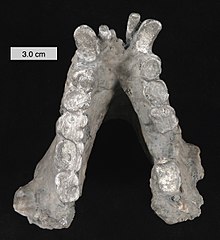Gigantopithecus
|
Gigantopithecus Temporal range: Late Miocene to Middle , 9–0.1 Ma |
|
|---|---|
 |
|
| G. blacki lower mandible cast | |
| Scientific classification | |
| Kingdom: | Animalia |
| Phylum: | Chordata |
| Class: | Mammalia |
| Order: | Primates |
| Family: | Hominidae |
| Subfamily: | Ponginae |
| Genus: |
†Gigantopithecus von Koenigswald, 1935 |
| Species | |
|
†Gigantopithecus blacki |
|
†Gigantopithecus blacki
†Gigantopithecus bilaspurensis
†Gigantopithecus giganteus
Gigantopithecus (from the Ancient Greek γίγας gigas "giant", and πίθηκος pithekos "ape") is an extinct genus of ape that existed from perhaps nine million years to as recently as one hundred thousand years ago, in what is now China, India, and Vietnam, placing Gigantopithecus in the same time frame and geographical location as several hominin species. The fossil record suggests that individuals of the species Gigantopithecus blacki were the largest known apes that ever lived, standing up to 3 m (9.8 ft), and weighing up to 540 kg (1,190 lb).
The first Gigantopithecus remains described by an anthropologist were found in 1935 by Ralph von Koenigswald in an apothecary shop. Fossilized teeth and bones are often ground into powder and used in some branches of traditional Chinese medicine. Von Koenigswald named the theorized species Gigantopithecus.
Since then, relatively few fossils of Gigantopithecus have been recovered. Aside from the molars recovered in Chinese traditional medicine shops, Liucheng Cave in Liuzhou, China, has produced numerous Gigantopithecus blacki teeth, as well as several jawbones. Other sites yielding significant finds were in Vietnam and India. These finds suggest that the range of Gigantopithecus was in southeast Asia. There are presently three extinct named species of Gigantopithecus: G. blacki, G. bilaspurensis, and G. giganteus.
In 1955, 47 G. blacki teeth were found among a shipment of "dragon bones" (also called "oracle bones") in China. Tracing these teeth to their source resulted in the recovery of more teeth and a rather complete large mandible. By 1958, three mandibles and more than 1,300 teeth had been recovered. Gigantopithecus remains have come from sites in Hubei, Guangxi, and Sichuan, from warehouses for Chinese medicinal products, as well as from cave deposits. Not all Chinese remains have been dated to the same time period, and the fossils in Hubei appear to be of a later date than elsewhere in China. The Hubei teeth are also larger.
...
Wikipedia
